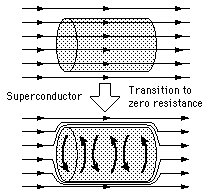The Meissner Effect
When a material makes the transition from the normal to superconducting
state, it actively excludes magnetic
fields from its interior; this is called the Meissner effect.
This constraint to zero magnetic field inside a superconductor is
distinct from the perfect
diamagnetism which would arise from its zero electrical resistance.
Zero resistance would imply that if you tried to magnetize a
superconductor, current loops would be generated to exactly cancel the
imposed field (Lenz's
law). But if the material already had a steady magnetic field through
it when it was cooled trough the superconducting transition, the magnetic
field would be expected to remain. If there were no change in the applied
magnetic field, there would be no generated voltage (Faraday's
law) to drive currents, even in a perfect conductor. Hence the active
exclusion of magnetic field must be considered to be an effect distinct
from just zero resistance. A mixed
state Meissner effect occurs with Type
II materials.
One of the theoretical explanations of the Meissner effect comes from
the London
equation. It shows that the magnetic field decays exponentially inside
the superconductor over a distance of 20-40 nm. It is described in terms
of a parameter called the London
penetration depth.
|


